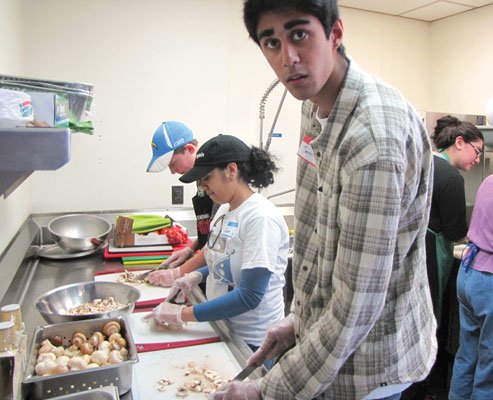Members of a community discussion of homelessness threw out
ideas such as a detoxification center, a
”
rotating
”
encampment that could be hosted by several local churches, a day
labor hub and a
”
one-stop
”
center where homeless people can receive access to various
services as ways to improve the city and its transient
population.
Members of a community discussion of homelessness threw out ideas such as a detoxification center, a “rotating” encampment that could be hosted by several local churches, a day labor hub and a “one-stop” center where homeless people can receive access to various services as ways to improve the city and its transient population.
These ideas will be incorporated into a document that the City Council will review during a study session later this summer, Police Chief Denise Turner said.
The police department’s homeless outreach committee gathered more than 40 community members at South Valley Community Church on Friday to discuss ways to creatively resolve homelessness issues. The forum included City Councilmen Peter Arellano and Dion Bracco as well as business leaders and representatives from social service agencies and faith groups.
“The (local) need is continuous and bigger than one agency can support,” said Marty Estrada, homeless outreach coordinator for Gilroy-based St. Joseph’s Family Center. “We need to put it all together and have one voice that’s recognized and heard.”
A 2009 homeless survey commissioned by Santa Clara County calculated that about 599 Gilroyans – or more than 1 percent of the city’s population – were homeless. While this number was down from 660 in 2007, the city still had the highest rate of homeless people per capita in Santa Clara County.
Arellano said he has received calls about homeless people sleeping in residents’ yards, urinating in public and panhandling in front of businesses. As a result, the issue of homelessness affects everyone, he said.
“There is no one in this city, this county and probably this state and this country who is not touched by homelessness,” Councilman Peter Arellano said.
Homeless residents cannot get a job if they are not bathed and well groomed, and the mentally ill will not do that if they do not have access to medication, Arellano said.
“If they don’t have benefits, they’re left on the street,” Arellano said. “And who picks them up? Police. It’s a waste of resources.”
Homelessness has a negative economic impact on Gilroy, Turner said. She gave the example of one homeless woman who was arrested 12 times. It took officers 36 hours of staff time to transport her to county jail, and cost taxpayers $1,900 in the process, she said. That is particularly a drain on the community when police already have had to make staffing cuts.
Studies indicate it costs twice as much to provide hospitalization for homeless people on the street as it does to provide them with permanent supportive housing, in which they are equipped with help from case managers, said Dina Campeau, homeless outreach committee member and a board member for the South County Collaborative – an association of nonprofit and public human services agencies.
The Gilroy Police Department seeks to have a stance of both compassion and practicality when dealing with homeless people, Turner said. For instance, police will abate an illegal encampment if they receive community complaints, but they hand a list of local resources to encampment residents, she said.
The city is also in the process of drafting an ordinance that will restrict panhandling in certain areas and prevent harassment by solicitors. The council is expected to vote on the matter May 18. However, there needs to be more solutions to help homeless people get back on their feet, she said.
“The problem I see is that we’re just spreading (homeless people) around because there is no permanent housing in Gilroy,” she said.
The county needs at least 2,730 permanent supportive housing units to meet the needs of its homeless population, said Bob Dolci, homeless concerns coordinator for Santa Clara County. A 26-unit complex to be built by South County Housing near First Street and Farrell Avenue should help, Dolci said, as 17 of the 26 units are for transient and mentally ill individuals.
Still, several attendees said the South County is at a disadvantage as mental health services and some other agencies used by homeless people are not locally available.
Downtown developer Gary Walton urged the City of Gilroy to team up with Morgan Hill as it seeks to address homelessness issues.
Attendees also cited successful programs in other cities, such as a community of “Tough Shed”-type residences for homeless people in Fresno. Turner also discussed a program in Seattle in which various churches take turns running a roving homeless encampment.
Community Solutions CEO Erin O’Brien recommended the city work with those who just need a little bit of help to get back on their feet again after hearing that police are already focusing on helping transients that cost the city the most money.
Campeau also challenged each church at the meeting to adopt a homeless person and help that person get back onto his or her feet.
South Valley Community Church youth pastor Isaac Serrano suggested that local churches team up to host an outdoor church service for homeless residents.
“People need to know that they value and worth,” he said.
Homeless people also need to have input in the process, said David Cox, director of St. Joseph’s Family Center.
“We need to hear directly from them to learn what are their trials and tribulations,” Cox said. “We need to put a face on this issue. These are our brothers and sisters.”
At least one Gilroy homeless man voiced his opinion during Friday’s forum.
Dustin Hellstern, who is currently living with a friend, said a lack of employment keeps many people from being housed.
“These guys are able to work, it’s just nobody’s going to hire them,” he said.
Local homeless people need to have better access to mental health services and transportation, he said.
“If I can’t get $2 for a prescription, how am I going to get $6 for a bus pass?” Hellstern asked. “There’s too many hoops to jump through.”
Arellano urged involvement by the local Latino community as well, as statistics indicate that 76 percent of South County’s homeless residents are Hispanic.
Turner said she was pleased with the turnout Friday at the forum, which mostly was for invited guests, and she was encouraged by their interest.
Former City Administrator Jay Baksa, who moderated at the forum, stressed that homelessness is of prime importance to the community and that local involvement is essential.
“A lot of people don’t care about this topic,” Baksa said. “Having been in the public sector, I say you have got to get people to care.”














